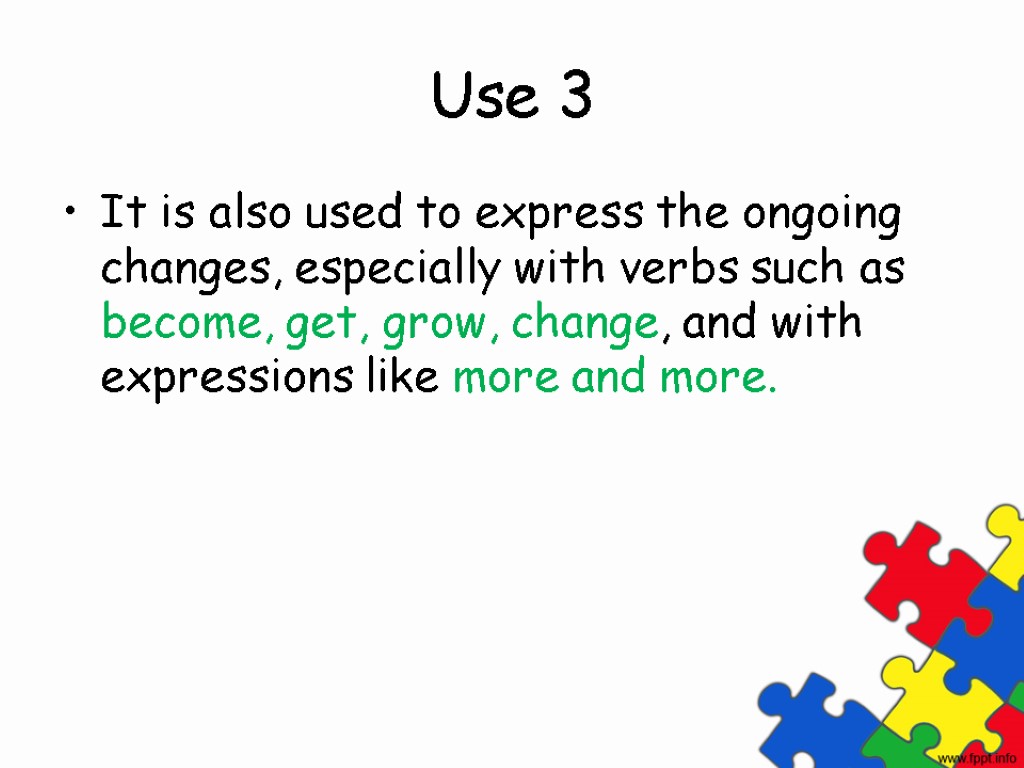 The Present Continuous Tense Use and form
The Present Continuous Tense Use and form
 What is she doing? She is reading a book.
What is she doing? She is reading a book.
 What is she doing? She is crying.
What is she doing? She is crying.
 What’s he doing? He’s watching TV.
What’s he doing? He’s watching TV.
 Where’s he going? He’s going to school.
Where’s he going? He’s going to school.
 And what are you doing right now? We are studying English grammar.
And what are you doing right now? We are studying English grammar.
 Use 1 The previous examples show that we use this tense to denote an action happening at the time of speaking (adverbs: now, right now, at the moment)
Use 1 The previous examples show that we use this tense to denote an action happening at the time of speaking (adverbs: now, right now, at the moment)
 What are they wearing today? They are wearing T-shirts and mini skirts today.
What are they wearing today? They are wearing T-shirts and mini skirts today.
 I’d love to see you. Are you busy? Unfortunately, I’m rather busy. I’m painting my flat this week.
I’d love to see you. Are you busy? Unfortunately, I’m rather busy. I’m painting my flat this week.
 Are you having fun this summer? Not really. I’m working as a waiter. I need some money for college.
Are you having fun this summer? Not really. I’m working as a waiter. I need some money for college.
 Use 2 These examples show that the Present Continuous Tense is also used to denote a temporary action happening today or these days.
Use 2 These examples show that the Present Continuous Tense is also used to denote a temporary action happening today or these days.
 What’s wrong with our planet? It’s getting warmer.
What’s wrong with our planet? It’s getting warmer.
 What’ wrong with the air we breathe? It’s becoming more and more polluted.
What’ wrong with the air we breathe? It’s becoming more and more polluted.
 Use 3 It is also used to express the ongoing changes, especially with verbs such as become, get, grow, change, and with expressions like more and more.
Use 3 It is also used to express the ongoing changes, especially with verbs such as become, get, grow, change, and with expressions like more and more.
 Are you going to the party on Friday?
Are you going to the party on Friday?
 We’re leaving tomorrow.
We’re leaving tomorrow.
 Use 4 We use it for future arrangements with a time reference.
Use 4 We use it for future arrangements with a time reference.
 Form – am, are, is + ing form Affirmative I am sleeping. He/she/it is sleeping. You/we/they are sleeping. Negative I am not (I’m not) singing. He/she/it is not (isn’t) singing. You/we/they are not (aren’t) singing. am, is, are + ing form
Form – am, are, is + ing form Affirmative I am sleeping. He/she/it is sleeping. You/we/they are sleeping. Negative I am not (I’m not) singing. He/she/it is not (isn’t) singing. You/we/they are not (aren’t) singing. am, is, are + ing form
 Form - continued Interrogative Am I dreaming? Is he/she/it dreaming? Are you/we/they dreaming? Short answers Yes, I am/he is/we are… No, I’m not/he isn’t/we aren’t…
Form - continued Interrogative Am I dreaming? Is he/she/it dreaming? Are you/we/they dreaming? Short answers Yes, I am/he is/we are… No, I’m not/he isn’t/we aren’t…
 ing form – spelling rules Most verbs just take –ing with no changes in spelling: watch-watching, clean-cleaning, listen-listening Verbs ending in –e drop it before –ing: live-living, write-writing Verbs with short vowels and one consonant double the consonant: run-running, swim-swimming
ing form – spelling rules Most verbs just take –ing with no changes in spelling: watch-watching, clean-cleaning, listen-listening Verbs ending in –e drop it before –ing: live-living, write-writing Verbs with short vowels and one consonant double the consonant: run-running, swim-swimming
 ing form – spelling rules Verbs ending in –l, double it: travel-travelling, cancel-cancelling Verbs ending in –ie change it to –y: lie-lying, die-dying
ing form – spelling rules Verbs ending in –l, double it: travel-travelling, cancel-cancelling Verbs ending in –ie change it to –y: lie-lying, die-dying











































